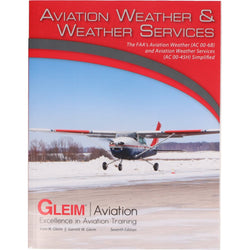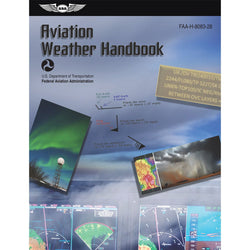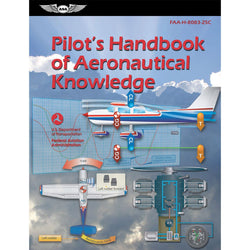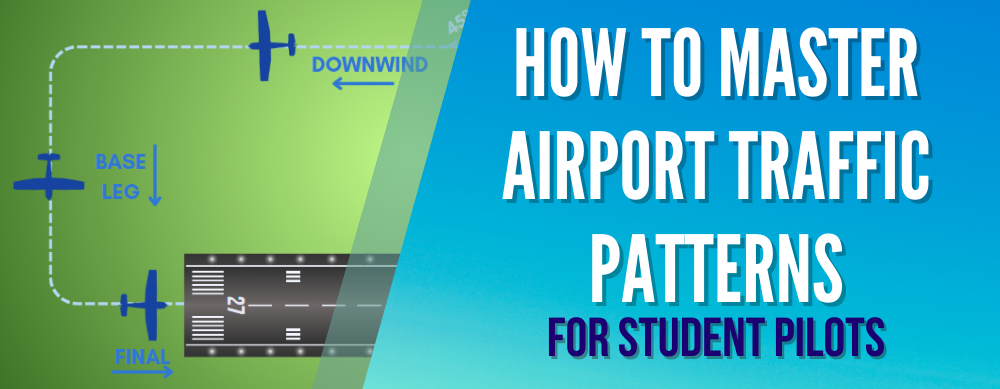Clouds are a very important indicator of aviation weather conditions. Kids enjoy finding bunnies and dinosaurs in the puffy white clouds on a summer day, but for pilots, clouds have a different story to tell.
By observing the sky, recognizing cloud types, and knowing what weather conditions each cloud is associated with, we can spot trouble early and avoid flying near dangerous clouds altogether.
So, how are your cloud identification skills? Do you know which types of clouds are the most dangerous for aircraft and which signal a smooth ride ahead?
Join us for a fun refresher on cloud categories, families, types, and what you need to know about each of the twelve most important kinds of clouds.
What causes clouds?
First, some basic weather theory. Cloud formation is caused by the condensation or sublimation of moisture in a cooling atmosphere.
Moist air rises, expands, and cools as it is carried upward on vertical air currents. Once the cooling air reaches a certain temperature, the molecules are saturated and condensation (otherwise known as clouds) form.
This temperature level is known as the dewpoint, and it varies. The dewpoint depends on how much humidity is already in the atmosphere. Damp air will reach its dewpoint faster and at a lower altitude than dry air.
When air masses of different pressures, temperatures, and moisture content come together, cloud formations are likely at the front between the air masses.
Air must be rising for clouds to form and stay together. Once air stabilizes and updrafts cease, clouds will dissipate.
How fast does air travel inside a cloud?
The faster air rises, the larger and more significant precipitation the cloud can produce. For example, speeds needed for initial cloud formation are much slower than those required to produce large hailstones.
Airspeeds needed for each type of precipitation:
- Cloud droplet: 02 mph
- Small rain droplet: 5 mph
- Large rain droplet: 20 mph
- Large hailstone: 100 mph

Pro Tip: What this means to pilots is that the larger, more significant precipitation a cloud is producing, the higher and more dangerous the vertical air speeds are in and near the cloud.
How Clouds are Named
Did you know many of the cloud categories and types we use today were first presented in London in 1802 by amateur meteorologist Luke Howard? When sharing his naming conventions, Howard pointed out that the different types of clouds are important as they are “good visible indicators” of otherwise invisible atmospheric variations.
Howard developed the three basic cloud classifications for our structural cloud categories. He combined those names to form four other individual cloud types that are part of the expanded cloud type list in use today.

3 Major Categories of Clouds
Clouds are grouped into categories based on their structural characteristics. There are many individual cloud types, but those in each structural category share common traits.
The three major structural categories of clouds are:
- Cirrus or cirriform
- Stratus or stratiform
- Cumulus or cumuliform
Cirrus Clouds
The word cirrus means “curl of hair.” Clouds in the cirriform family have a wispy, hair-like appearance and are usually white or light grey colored.
Stratus Clouds
The word stratus means “spread.” Stratiform clouds are flat, layered, horizontal clouds created by moist air flowing over cold surfaces. These clouds can range from white to medium grey in color. IFR pilots can safely fly through stratus clouds because they develop in relatively stable atmospheres where there is limited vertical airflow.
Cumulus Clouds
The word cumulus means “heap.” Clouds in the cumulus family have fluffy tops and a flat base. They can be stand-alone, grouped in clusters, or in line with other cumulus clouds. These clouds range from white to very dark grey in color.
4 Major Cloud Family Groups
In addition to the structural categories, clouds can also be grouped into the following “cloud families” based on their altitudes:
- High altitude
- Mid altitude
- Low altitude
- Vertical development
High Altitude Clouds (Above 20,000 feet)
By the time moist air reaches 20,000 feet and above, the water droplets have frozen and turned to ice crystals. The three variations of clouds found at high altitudes have similar composition, but different names based on their shapes. High altitude clouds are all part of the cirriform category.
Mid-Altitude Clouds (Above 6,500 feet)
Clouds that develop between 6,500 and 20,000 feet start with the prefix “alto.” When you see an increased concentration of mid-altitude clouds, expect lower-level clouds and precipitation.
Low-Altitude Clouds (Below 6,500 feet)
The lowest altitude clouds have names based only on their structural categories. For example, flat low-level clouds have “stratus” in the name and lumpy ones have “cumulus.”

Aviation Weather Trivia: When a low cloud touches the ground, it gets a new name: fog.
Clouds with Vertical Development
The most visually impressive clouds are towering vertical clouds that can extend from low to high altitudes. These clouds form rapidly when a cold front slides underneath and vertically displaces a warm front. Clouds with vertical development are some of the most dangerous for pilots due to the rapid and fluctuating airflow inside them.
12 Most Common Types of Clouds
Now that we’ve covered cloud categories and families, lets cover the types of clouds in aviation. There are twelve individual types of clouds you may see while flying:
1. Cirrus Clouds
Cirrus clouds are thin, wispy ice crystal-filled clouds that look like hairs or ‘mare’s tails.’ The bits of snow that fall from these high-altitude clouds quickly evaporate.
2. Cirrocumulus Clouds
When cirrus clouds group together in lumpy, flaky patches, they are called cirrocumulus or “mackerel scales” since they look like fish scales.
3. Cirrostratus Clouds
Nearly solid sheets of flat high-altitude clouds that give a slight milky appearance to the sky are called cirrostratus.
4. Altostratus Clouds
Altostratus clouds are flat, and bluish white in color. They blanket the mid-altitude sky and diffuse the sunlight as it filters through them. Translucent altostratus clouds produce visual phenomenon like sundogs and sun halos.
5. Altocumulus Clouds
Puffy white rows of cotton ball looking clouds are altocumulus. Although these mid-altitude clouds are often grouped in rows, they can appear solo as well.
6. Nimbostratus Clouds
Nimbostratus clouds are thick, flat, gray, shapeless clouds that form across the low-altitude sky. The prefix “nimbo” indicates precipitation. When combined with “stratus,” the name tells you this form of cloud will cover large areas of sky and produce light rain or snow.
7. Stratus Clouds
When stratus clouds form, the whole sky often appears overcast as layers of flat gray clouds block the sunlight. Expect low ceilings and poor visibility with this type of cloud cover at lower altitudes.
8. Stratocumulus Clouds
This combination cloud type covers a large area of low altitude sky like stratus clouds and has a puffy structure like cumulus clouds. Rays of sunlight called crepuscular rays or “Jesus’ rays” will shine through the small gaps in between the conjoined cloud puffs.
9. Cumulus Clouds
Puffy white, cauliflower-like cumulus clouds are low altitude clouds caused by small, localized high pressure patches causing updrafts. They are known to develop when moist airmasses flow over warm surfaces. These clouds can also be generated by air rising up the windward side of mountains. Pilots can usually avoid scattered cumulous clouds, but sometimes these clouds form an unbroken line.
10. Cumulonimbus Clouds
Towering vertical development and puffy, clearly defined edges make a cumulonimbus cloud easy to recognize. The cloud height is determined by the freezing level in the cloud.
In hot weather, cumulonimbus clouds can reach as high as fifty or sixty thousand feet. The higher this type of cloud grows, the more dangerous it is. Cumulonimbus clouds with a flattened anvil top have the potential to cause the most harm.
Rapidly shifting up and down vertical airflow within the cloud creates intense rain showers on the leading portion. Hail is often found near the freezing line and can fall to earth if it’s heavy enough. Static electricity builds as rapid airflow continues and it discharges as lightning.
11. Lenticular Clouds
Mountain ranges are home to a unique type of cloud that all pilots need to recognize. Stationary lens-shaped clouds develop when strong winds travel up the mountains. The air cools over the peak to form a lenticular cloud.
12. Mammatus Clouds
Mammatus clouds are a very dangerous subcategory of cumulonimbus clouds. A cumulonimbus mammatus cloud is a very dark grey, with a wavy underside rather than the flat bottom of a standard cumulonimbus. This rippled bottom indicates the very high levels of turbulence and possibility of tornadoes, microbursts, lightning, and hail in and near the cloud.
What does Cloud Color Tell You?
Cloud type and altitude give us important information, and so does cloud color. Here’s what you should know about each color of cloud:
- White: White clouds are the thinnest color of cloud. They scatter the sunlight.
- Gray: If a cloud is gray, that means partial sunlight is passing through. The cloud is less than 3,000 feet thick.
- Dark Gray: The darkest clouds are so thick they block nearly all the sunlight from passing through. Dark gray and almost black color clouds are more than 3,000 feet thick.
 What Each Cloud Type Means for Pilots
What Each Cloud Type Means for Pilots
Everything we’ve talked about so far is educational, but at the end of the day, you’re probably not reading up on aviation weather topics so you can be a contender on Jeopardy.
You want to know how each type of cloud impacts you as a pilot. For example, “Which clouds are dangerous for aircraft?” and “What types of clouds can pilots fly through?”
Now that we understand how to recognize individual clouds, we’ll share a quick, easy summary of what you as a pilot need to know about each cloud type.
Cirrus and Cirrocumulus Clouds: Watch for Developing Weather
Even if you spend little to no time flying above 20,000 feet, high level clouds can give early indicators of developing weather patterns. For example, a combination of cirrus and cirrocumulus clouds can signal storms on the way, hence the old fishermen’s saying that “Mares’ tails and mackerel scales make lofty ships carry low sails.”
Altostratus and Nimbostratus Clouds: Expect Low Ceilings & Watch for Rime Ice
Both alto and nimbostratus clouds bring lowered ceilings due to the evaporation of light rain causing saturation and condensation. The low ceiling can delay or cancel VFR flights.
In addition to low ceilings, pilots need to watch for rime ice development when flying in altostratus and nimbostratus clouds.
Stratiform Clouds: Enjoy Calm Air and Smooth Flight
Although lower ceilings and rime ice are possible in alto and nimbostratus clouds, one of the advantages of stratiform clouds is that they indicate areas of relatively stable air.
Cirriform Clouds: No Icing
Since high-level cirrus family clouds are already made of tiny ice crystals, they won’t cause ice to form on your aircraft.
Cumuliform Clouds: Watch Out for Turbulence and Icing
Cumulus family clouds get their height due to significant vertical airflow. This means pilots should expect turbulence in and near cumuliform clouds. Even small groups of white puffy cumulus clouds can be warning signs for upcoming turbulence.
Also watch for both the development of clear, mixed, and rime ice if flying in or near a cumuliform cloud. Clear ice forms at temperatures of 2 ° C to -10° C, mixed ice forms at -10° C to -15° C, and rime ice develops when the temperature drops to -15° C to -20 ° C.
Lenticular and Mammatus Clouds: Avoid the Area
Avoid flying close to lenticular clouds because they are important indicators of localized strong wind and heavy turbulence along mountain ranges.
Mammatus clouds are also highly dangerous as they can harbor severe storms and damaging precipitation.
How to Measure Cloud Cover
The density of cloud cover makes a difference too. When you get a pilot weather report detailing cloud cover, here’s how to interpret it:
- Clear: No clouds
- Few Clouds: Clouds covering 1/8 to ¼ of the sky
- Scattered Clouds: Clouds cover 3/8 to ½ of the sky
- Broken Clouds: Clouds cover 5/8 to 7/8 of the sky
- Overcast: Clouds cover all of the sky

Pro Tip: You can get an initial cloud cover report from the National Weather Service, just know that the public terms for cloud cover are different from those used by pilots. The NWS will say the sky is clear, mostly clear (at night)/mostly sunny (day), partly cloudy, mostly cloudy, or overcast.
Know Your Clouds
It may not have scored a spot on our all-time best movies about flying list or our must watch aircraft documentaries round up, but the “Know Your Clouds” 1966 U.S. Army Aviation Training Film is still a worthy watch for visual learner pilots who want a sixteen minute crash course on ten basic cloud types.
“Know Your Clouds” covers:
- Cloud names, symbols, altitudes
- How, when, and where each develops
- Key traits of each cloud
- Related flight hazards (if any)
More Cloudy Day Reading
Continue learning when you pick up a copy of the ASA’s Aviation Weather. This book is one of the ultimate guides to understanding, recognizing, and responding appropriately to all types of marginal and hazardous weather conditions including those involving clouds.
We also suggest the following blog posts for more weather and cloud-related reading:
- Flying in Thunderstorms (What to Do & What Not to Do)
- Scud Running: Reasons Why You Should Be Wary of Doing It
- Airspace Visibility Requirements: Why are they Mandatory?
- Cloud Ceilings: What Pilots Should Know (Complete Guide)
 It’s Your Turn
It’s Your Turn
We’d love to hear from you. How have you used cloud indicators to help plan or adjust your flight path? Any best practices or weather resources you’d like to share with your fellow pilots? Let us know in the comments below!












![The 6 Best Flight Simulator Yokes, Pedals & Controls [Updated 2024]](http://www.pilotmall.com/cdn/shop/articles/The_6_Best_Flight_Simulator_Yokes_Pedals_Controls_9aed5eb1-3ef1-44cd-ab7b-5af1e6d01f60.png?v=1713470781&width=1000)